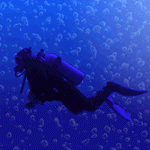Garabeca wrote: ↑Fri May 01, 2020 7:28 pmGarabeca wrote: ↑Fri May 01, 2020 7:20 pmAlso wanted to point out, something is causing the false event flags and it surely isn't because the pressure is too high. His body is sore, that equals to his body being tired and in a recovery process. In no ordinary world will a tired and sore body due to exercise, require less oxygen to operate. And so, more oxygen demands more pressure as simple as that. Other wise he will mouth breathe (false event flag) or experience lack of airflow/oxygen which will cause him to snore and struggle (false event flag) as his tidal volume rise from his usual baseline pressure is not being met anymore for that 24-48 hours window (depending on the intensity of the exercise) where the body is in need of more oxygen, thus Creating false event flags. Unfortunately, the APAP is only a good machine for sporadic need of pressure increase throughout the night. But the baseline pressure (also straight CPAP pressure) is what's important here on days the body is exhausted from exercise. ALso keep in mind, athletes will recover faster and might need even less than 24 hours to recover their regular need for oxygen intake. So this is case by case and applies for people who brought up this topic in the first place. And lastly, using this logic, exercising earlier will help but probably not for the same following night of sleep but most probably for the next day's night of sleep.Garabeca wrote: ↑Fri May 01, 2020 7:05 pmGarabeca wrote: ↑Fri May 01, 2020 6:59 pmThere is no harm in trying. One extra cm won't make such a difference anyways. I encourage people to "listen" to their bodies and if you can, get into analysing your own data on sleepyhead. That's what i did and that's how i finally got relief on exercise days. For most people, metabolism up regulates on exercise days. Tidal volume and minute vent increases. Nothing wrong with trying to match that with an extra cm to see if it helps things to be more comfortable.ChicagoGranny wrote: ↑Fri May 01, 2020 11:49 am
Probably. And, there is no need to raise the CPAP pressure to deal with false event flags.
His other problem is having a straight CPAP (according to his equipment profile).
Exercise and sleep apnea.
Re: Exercise and sleep apnea.
Re: Exercise and sleep apnea.
Garabeca wrote: ↑Fri May 01, 2020 7:30 pmGarabeca wrote: ↑Fri May 01, 2020 7:28 pmGarabeca wrote: ↑Fri May 01, 2020 7:20 pmAlso wanted to point out, something is causing the false event flags and it surely isn't because the pressure is too high. His body is sore, that equals to his body being tired and in a recovery process. In no ordinary world will a tired and sore body due to exercise, require less oxygen to operate. And so, more oxygen demands more pressure as simple as that. Other wise he will mouth breathe (false event flag) or experience lack of airflow/oxygen which will cause him to snore and struggle (false event flag) as his tidal volume rise from his usual baseline pressure is not being met anymore for that 24-48 hours window (depending on the intensity of the exercise) where the body is in need of more oxygen, thus Creating false event flags. Unfortunately, the APAP is only a good machine for sporadic need of pressure increase throughout the night. But the baseline pressure (also straight CPAP pressure) is what's important here on days the body is exhausted from exercise. ALso keep in mind, athletes will recover faster and might need even less than 24 hours to recover their regular need for oxygen intake. So this is case by case and applies for people who brought up this topic in the first place. And lastly, using this logic, exercising earlier will help but probably not for the same following night of sleep but most probably for the next day's night of sleep, that is if you absolutely do not want to adjust the pressure settings.Garabeca wrote: ↑Fri May 01, 2020 7:05 pmGarabeca wrote: ↑Fri May 01, 2020 6:59 pm
There is no harm in trying. One extra cm won't make such a difference anyways. I encourage people to "listen" to their bodies and if you can, get into analysing your own data on sleepyhead. That's what i did and that's how i finally got relief on exercise days. For most people, metabolism up regulates on exercise days. Tidal volume and minute vent increases. Nothing wrong with trying to match that with an extra cm to see if it helps things to be more comfortable.
Re: Exercise and sleep apnea.
And something to remember is that he's older, not a pro athlete (even if he ever was long ago) and likely has other conditions that complicate his story. Not everything's about OSA or Cpap, and I'm sure it's ok to play with 1-2 cm at a given time for a few days, but it's also important to try one thing at a time for a while and then another, to be very sure about what is responsible for which symptom, etc. and not just make assumptions.
Re: Exercise and sleep apnea.
Exactly! That's exactly the message i'm trying to send, to remember the therapeutic pressure that was assigned to you by the medical corps initially, and adjust accordingly to see if you can be more comfortable depending on certain stressors that come and go. In my experience, lowering up to 1cm is okay for trial and error purposes but more than that might be detrimental. Because AHI might be stable for a little while, even with a lower pressure (as it has been studied in the long term complying patient, that often a few days following cpap discontinuaison AHI is somewhat better until it declines again) therefore, unless there has been drastic changes in someone's health condtion (example weight loss) odds are that a lower pressure than what was established in the initial titration is not recommended, or at least not by more than 1-2 cm. In fact, doctors who assign an APAP give a wider range of pressure. For example, my titration established was at 12cm of pressure. My pneumologist assigned a pressure in between 10-14, because it is an APAP. If it were a straight CPAP, he most probably would have given me a 12 cm pressure. It is safe to assume therefore that one could tamper with his pressure within that 4cm range, 2 below or 2 above to determine his comfort level depending on life stressors, exercise ect. However chances are that increasing pressure higher than 1 cm might provide some discomfort especially if the body is not in a state of physical stress or i would even go as far as saying mental stress. But i think that we should always work around the initial ideal pressure established during the titration since this was analysed by a computer along the therapist real-time during the course of a night which we cannot do ourselves, or only to a certain extent by analysing our results the following day while letting the APAP give us a more or less approximation. Or in the case of straight CPAP, the results different pressures yield. But AHI results alone don't account for desaturations so definitely, unless we also have a pulse oximeter and we can interpret all the different stats with a software like sleepyhead , we should use the diagnosed pressure as our preffered and solid reference. I mean, that was the point of the million wires they attached to us during the titration night in the first place.Julie wrote: ↑Fri May 01, 2020 8:53 pmAnd something to remember is that he's older, not a pro athlete (even if he ever was long ago) and likely has other conditions that complicate his story. Not everything's about OSA or Cpap, and I'm sure it's ok to play with 1-2 cm at a given time for a few days, but it's also important to try one thing at a time for a while and then another, to be very sure about what is responsible for which symptom, etc. and not just make assumptions.
Last edited by Garabeca on Sat May 02, 2020 9:22 am, edited 1 time in total.
Re: Exercise and sleep apnea.
So, the bottom line is, if you exercise for example 3 times a week, but the 4 other days you don't. There is a chance that within that same week, your pressure needs will fluctuate. So in that case, be comfortable with the "hassle" of tampering with your machine to reduce discomfort. In my case for example, yesterday, i exercised. Last night, i increased my pressure by a centimeter. If i hadn't done that, my AHI would have been higher than usual (as confirmed in the past in my stats for all the other days i exercised with unaltered pressure) This time however, not only did i have a great night of sleep because i was getting the correct pressure i needed for my deeper breaths, but my AHI actually lowered by a lot! (0.43 an hour) Which was unseen for me before on days i would exercise when i wouldn't alter the pressure, on the contrary it would go much higher. (2-3 AHi an hour) Now here's the tricky part. When my metabolism will go back to baseline (if i dont exercise again in the next couple of days to match that need for higher pressure) And i leave the pressure to that 1cm higher, I will experience aerophagia and symptoms of the pressure being too high (discomfort of too much airfow for my now lowered tidal volume following the decrease in metabolism due to exercise cessation). In that case, the same way one has to be proactive in highering the pressure when needed, he also has to be proactive in lowering that pressure to baseline when no longer needed. So it's very important to be in tune with the airlflow and make it as natural as possible by being able to breathe very easily and comfortably. You have to feel the pressure not too high but definitely not too low and so enough to get enough air to take a deep breath effortlessly. In my experience, in relation to exercise, those differences in pressure are no longer a theory, it's a fact. And so it is surely a fact for others as well, they just have to find out with trial and error. It is crucial however to get the proper pressure on exercise days because sub-optimal pressure will counter the benefits of the deeper sleep exercise is supposed to induce and so the coveted recovery will not be achieved and might even be countered.Garabeca wrote: ↑Sat May 02, 2020 9:10 amExactly! That's exactly the message i'm trying to send, to remember the therapeutic pressure that was assigned to you by the medical corps initially, and adjust accordingly to see if you can be more comfortable depending on certain stressors that come and go. In my experience, lowering up to 1cm is okay for trial and error purposes but more than that might be detrimental. Because AHI might be stable for a little while, even with a lower pressure (as it has been studied in the long term complying patient, that often a few days following cpap discontinuaison AHI is somewhat better until it declines again) therefore, unless there has been drastic changes in someone's health condtion (example weight loss) odds are that a lower pressure than what was established in the initial titration is not recommended, or at least not by more than 1-2 cm. In fact, doctors who assign an APAP give a wider range of pressure. For example, my titration established was at 12cm of pressure. My pneumologist assigned a pressure in between 10-14, because it is an APAP. If it were a straight CPAP, he most probably would have given me a 12 cm pressure. It is safe to assume therefore that one could tamper with his pressure within that 4cm range, 2 below or 2 above to determine his comfort level depending on life stressors, exercise ect. However chances are that increasing pressure higher than 1 cm might provide some discomfort especially if the body is not in a state of physical stress or i would even go as far as saying mental stress. But i think that we should always work around the initial ideal pressure established during the titration since this was analysed by a computer along the therapist real-time during the course of a night which we cannot do ourselves, or only to a certain extent by analysing our results the following day while letting the APAP give us a more or less approximation. Or in the case of straight CPAP, the results different pressures yield. But AHI results alone don't account for desaturations so definitely, unless we also have a pulse oximeter and we can interpret all the different stats with a software like sleepyhead , we should use the diagnosed pressure as our preffered and solid reference. I mean, that was the point of the million wires they attached to us during the titration night in the first place.Julie wrote: ↑Fri May 01, 2020 8:53 pmAnd something to remember is that he's older, not a pro athlete (even if he ever was long ago) and likely has other conditions that complicate his story. Not everything's about OSA or Cpap, and I'm sure it's ok to play with 1-2 cm at a given time for a few days, but it's also important to try one thing at a time for a while and then another, to be very sure about what is responsible for which symptom, etc. and not just make assumptions.Love cats by the way lol.
- chunkyfrog
- Posts: 34545
- Joined: Mon Jul 12, 2010 5:10 pm
- Location: Nowhere special--this year in particular.
Re: Exercise and sleep apnea.
At my advanced age (nearly 73), pain is almost always with me.
In the daytime, it is easy to address or ignore--whatever works at the time.
I recently stopped taking ibuprofen at bedtime--(covid stuff on the news),
but have noticed that I cannot sleep as long (5-6 hours as opposed to 7-8)
Adding analgesics back in pushes my sleep time back up.
To hell with tv docs and their empty chatter!
In the daytime, it is easy to address or ignore--whatever works at the time.
I recently stopped taking ibuprofen at bedtime--(covid stuff on the news),
but have noticed that I cannot sleep as long (5-6 hours as opposed to 7-8)
Adding analgesics back in pushes my sleep time back up.
To hell with tv docs and their empty chatter!
_________________
| Mask: AirFit™ P10 For Her Nasal Pillow CPAP Mask with Headgear |
| Additional Comments: Airsense 10 Autoset for Her |
- DreamDiver
- Posts: 3082
- Joined: Thu Oct 04, 2007 11:19 am
Re: Exercise and sleep apnea.
There apparently was a clinical trial about exercise intolerance with OSAS. It lasted 2 years. The results unfortunately were never published. The study was done in France on only 60 people, 15 of whom were control.
It doesn't talk about whether AHI was affected in this study.
It only corroborates at least anecdotal concerns from a handful of other sleep apnea sufferers that it may have been worth a study to determine if there is a connection between sleep apnea and exercise intolerance.
It's possible - even likely - there is no connection.
I wonder why they never published the results.
Chris
It doesn't talk about whether AHI was affected in this study.
It only corroborates at least anecdotal concerns from a handful of other sleep apnea sufferers that it may have been worth a study to determine if there is a connection between sleep apnea and exercise intolerance.
It's possible - even likely - there is no connection.
I wonder why they never published the results.
Chris
_________________
| Mask: ResMed AirFit™ F20 Mask with Headgear + 2 Replacement Cushions |
| Additional Comments: Pressure: APAP 10.4 | 11.8 | Also Quattro FX FF, Simplus FF |

Most members of this forum are wonderful.
However, if you are the target of bullying on this forum, please consider these excellent alternative forums:
Apnea Board
Sleep Apnea Talk Forum
Free CPAP Advice
Be well,
Chris










